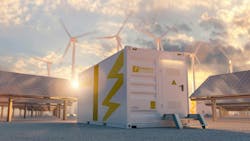5 Key Considerations for Energy Storage in Distributed Energy Applications
July 30, 2024
6 min read
Our power grid is changing, becoming more distributed and more renewable than ever before. Battery energy storage is a critical technology component to reducing our dependence on fossil fuels and building a low-carbon future. Without it, this change will be impossible. Microgrids, net zero buildings, and local renewable energy resources are all enabled by energy storage.
A Distributed Energy Resource (DER) is an electricity generation system that includes several small-scale devices located closer to the demand as opposed to a centralized power plant and distribution network. DER is also referred to as a distributed energy grid. DERs play an increasingly significant role in the transition toward cleaner energy systems as businesses and individual consumers add energy generation capabilities to their homes and businesses.
There are fundamental differences between traditional fossil fuel energy and the renewable energy used in DERs. Wind and solar energy rely on the wind blowing and the sun shining, whereas centralized non-renewable resources like coal can be burned whenever power is needed.
DERs Are Made Possible by Energy Storage
Energy storage is critical in distributed energy systems to decouple the time of energy production from the time of power use. By using energy storage, consumers deploying DER systems like rooftop solar can, for example, generate power when it’s sunny out and deploy it later during the peak of energy demand in the evening.
Consequently, energy storage systems play a pivotal role in advancing clean energy objectives by enhancing the efficient utilization of renewable resources and simultaneously enhancing grid reliability and pricing stability.
In addition to applications in the grid, energy storage is also used in commercial and industrial applications to enhance the reliability of energy availability and reduce costs by using stored power during times when grid power is particularly expensive.
Residential homes or small communities can also use energy storage to achieve better energy independence and environmental sustainability by connecting energy storage systems to distributed energy resources like rooftop solar.
Important Considerations for Implementing Energy Storage
The International Renewable Energy Agency estimates that 90% of the world’s electricity may come from renewables by 2050. This necessitates a massive increase in renewable power generation. However, there are a few key considerations to keep in mind when implementing energy storage:
- Footprint Reduction: Given the limited physical space available in various applications, such as grid installations, EV charging stations, and commercial and residential buildings, reducing the footprint of energy storage systems is crucial. This involves optimizing technology and design to maximize the storage capacity within a smaller physical footprint.
- Infrastructure Support: Energy storage installations require appropriate infrastructure support to accommodate the batteries and associated components. This includes considerations for cooling systems, electrical connections, and structural support to ensure efficient operation and safety.
- Scalability: The ability to scale energy storage systems according to demand is critical, especially in applications where growth is anticipated, such as microgrids and EV charging stations. Modular designs that allow for easy expansion or replication of storage capacity can effectively support future needs.
- Regulatory Compliance: Compliance with regulatory standards and guidelines related to safety, environmental impact, and grid interconnection is essential. Ensuring that energy storage installations meet all relevant regulations and standards is critical for successful implementation.
- Cost-effectiveness: Assessing the overall cost-effectiveness of energy storage solutions, you must weigh upfront costs and maintenance expenses against potential savings and/or new business opportunities from improved energy management. Implementing systems that offer a favorable return on investment over their lifecycle is key to widespread adoption.
Technologies to Support These Considerations
Those looking to implement energy storage in distributed grid applications must find the right technologies. While needs might be different depending on the scale of an installation, and many OEMs will sell complete systems, the performance of the following technologies will affect the performance of energy storage systems as a whole.
- Cooling Technology: To maintain both performance and safety, batteries must be cooled. There is a wide range of cooling technologies deployed in energy storage systems depending on the power density of a particular installation. For many systems, air conditioning is a good solution. Air cooling is becoming more efficient, and many companies are looking at the refrigerants they use to make them more environmentally friendly. For larger installations or applications with higher energy density, liquid cooling technology, where chilled liquid lines carry heat away from batteries to a chiller, is the best option due to superior efficiency and effectiveness.
- Flexible Conductors like busbars or braids can facilitate the integration of energy storage systems in tight spaces by minimizing bend radius requirements. These solutions allow for easier installation and a reduced overall footprint compared to traditional cable and lug systems.
- Advanced Battery Technology is fundamental to energy storage systems. Lithium-ion batteries are commonly used due to their high energy density, scalability, and relatively long lifespan. Lithium Iron Phosphate technology has come a long way and is helping reduce the total cost of energy (TCOE) for energy storage users.
- Advanced Materials: The development of advanced materials and environmental protection, such as lightweight and durable enclosure materials, reliable gasket and enclosure designs, thermal cable coatings, fire-resistant materials, and low-smoke zero-halogen insulation, contributes to the safety, efficiency, and longevity of energy storage systems.
Demand for energy storage will continue to grow as government investments in infrastructure increase worldwide, microgrids become more common, and electric vehicles become widely adopted.
Reducing footprint while providing reliable environmental protection, liquid cooling, and efficient electrical distribution and grounding for energy storage systems will be a challenge for battery module manufacturers, power companies, commercial buildings, and others. Thinking about these challenges and developing technology to address them now will help energy storage companies get ahead of the competition.
About the Author
John Turner is the Vertical Growth Leader for Renewable Power Generation and Energy Storage at nVent. He is responsible for driving technology development, mindshare, and growth in these key areas.
He brings a deep understanding of the challenges facing the energy industry and a passion for finding innovative solutions that benefit both customers and the environment. He is committed to advancing the adoption of sustainable energy practices and is a vocal advocate for the role that Renewable Power Generation and Energy Storage can play in shaping a more sustainable future.
Sign up for our eNewsletters
Get the latest news and updates

